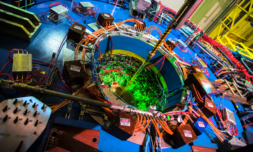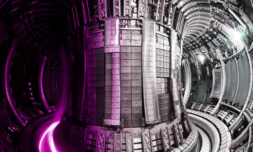A team of Oxford scientists has just potentially paved the way for the large-scale, practical use of quantum supercomputers.
Humanity has finally solved the puzzle of teleportation – in the world of quantum supercomputers, that is.
A group of Oxford scientists believe their breakthrough will be huge in bringing quantum supercomputers to scale, ultimately ushering in a new era of efficiency and discovery across all modern industries.
To the uninitiated (which encompasses most of us), a quantum supercomputer is essentially a regular computer on steroids. It has incredible processing power, and surpasses the capabilities of its binary predecessor by using ‘qubits’ – a unit of information which can be both 0 and 1 at the same time.
Basically, if you envision regular computers as being either heads or tails on the flip of a coin, a quantum computer would effectively be the coin spinning on its side offering up both possibilities at once. Its processers are far more advanced, making quantum computing perfect for complex problem solving and aiding previously intangible discoveries.
It sounds like a match made in heaven for AI, right? Imagine a tailor-made algorithm rapidly throwing together untested drug combinations while a quantum supercomputer simulates how molecules behave and interact at an atomic level. Theoretically, we’re talking about the end of arduous and slow laboratory testing altogether.
When you think about the potential of the technology, the applications are truly endless and would permeate just about every modern industry you can think of.
Frustratingly, however, several practical hiccups continue to hold it back from a mainstream explosion. Chief among them is the eyewatering cost of building and maintaining the computers. For one, achieving quantum state requires near absolute zero temperatures and electromagnetic shielding to prevent pesky errors.
On the upside, though, the major headache of scalability has received a monumental boost offering renewed hope of an imminent quantum revolution.
This arrives courtesy of British scientists at the University of Oxford, who successfully linked two separate quantum processers together without the use of physical hardware, in-essence forming one powerful interconnected quantum computer.
For clarity, deploying a supercomputer on any ambitious widescale project would likely require millions of qubits, and today’s most advanced models only have 5,000 at best. What these researchers have shown, however, is that it is possible to combine the processing power of multiple quantum computers into a single network chain.

Although quantum teleportation has been achieved previously, this is the first instance in which quantum logical gates – the building blocks of computer algorithms – has been shared between distant computers. In simple terms, the previous feat of sharing, say, a letter has now been trumped by sending an entire sentence or prompt.
Previous studies have shown that supercomputers can communicate from hundreds of kilometres away through transmitting photons along fibre-optic cables or satellite lasers, meaning that a network of quantum processors could be exploited across borders without needing one centralised hub.
So, while work is needed to achieve the dream of scaling up our quantum capabilities to qubits in the millions, we’ve already accomplished a scenario where quantum computers can consolidate their power to vastly outperform regular computers.
The Oxford researchers reiterate that their newly discovered means of quantum teleportation could form the foundation of a future ‘quantum internet’ with an ultra-secure network for communications, solving complex problems, and precisely sensing environmental changes.
There you have it, then. Engineering breakthroughs are still required to exploit quantum computing on the level we envision, but we’re now at a level where we can begin to experience a glimpse of what the technology is capable of.

















